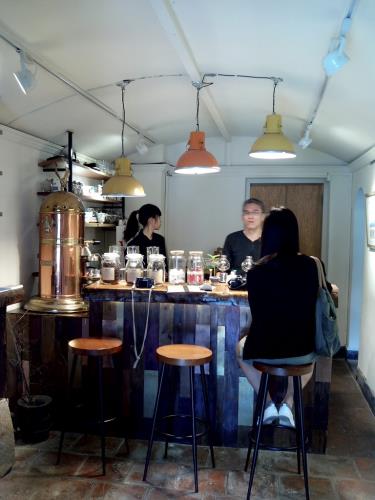Eugenia Lo is an independent journalist and editor. She is a Master of Criminology researching the public security system in Mainland China. With a strong family ties in Macao, Lo is a constant researcher of the city’s cultural and social development. Over the years, Lo works with many international corporations and institutes including the University of Hong Kong, British Council, Commercial Press (H.K.), Joint Publishing (H.K.), etc. for various editing, PR and translation projects.

Recently, I travelled to Taipei with a friend, who is a Christian History researcher. Hence some of the Christianity related historical spots were included in our itinerary, including the Aletheia University in Tamsui. When we arrived at Buk Su Lao (The House of Reverends), a small café facing a beautiful garden at the lower floor of the building caught our attention.
This café was not in our original plan, but my coffee addiction suddenly kicked in and I could not resist ordering a cup. We sat at the coffee bar and watched the owner to brew our coffee. I also took my time to appreciate the interior of the café. The retro-designed copper espresso machine, wooden furniture and the little angel ceramic dolls by the window all match perfectly with this 1909 colonial-style building with fine pointed masonry and red brick porch. With the cultural products and artworks in the café, we could easily spend an afternoon here and relax myself if we did not have other plans for later.
Bok Su Lao was originally built for Reverend William Gauld’s as his residence in 1909. After his passing in 1923, the house became the residence of Reverend Hugh MacMillan, who served at Taipei Theological School, then Reverend James I. Dickson at Tamkang High School. Originally this red building had nothing to do with coffee, but Kevin Lin, the owner of Bok Su Lao Café told me it was fate that linked the hundred-year-old building, coffee and himself together. Besides, the Taiwan Government is supportive for heritage preservation and revitalisation, Lin thus took this good opportunity to convert a small room in the building into a café. He is also the interior and product designer of the café. The main product is freshly-brewed coffee of course, along with over 20 specially designed cultural products such as artwork in the shape of coffee beans, the founder of the Aletheia University Reverend George Leslie Mackay and Christianity-related products, also photos and drawings by Lin himself. Personally my favourite products are the coffee mugs with the line drawing of Bok Su Lao and decorative tapes printed with the university’s buildings.
Apart from being creative, Lin also wants to show his customers the spirit of service. “We can save the postcards written by our customers and post them on a designated date. This special service allows the customers and their friends afar to feel the warmth of handwriting and also the spirit of Mackay.” Speaking of human touch, Lin also organises art exhibitions and rents the venue to local artists for special events such as art classes and reading clubs. His effort is supported and appreciated by customers and artists, thus he expects to increase the sale proportion of the creative cultural products in the future.
Opening a shop in a historical spot is unique but not without obstacles. The owner has to follow the regulations strictly and cannot alter the interior or exterior of the building without permission. The simple interior design of Bok Su Lao is a good solution. Lin makes use of his own creative products and artworks to create a sense of style and show the customers his passion. He involves in the operation and quickly learn about the customers’ preferences and improve his service promptly.
There are shops and restaurants in some of Macao’s historical buildings. The Macao S.A.R Government and the Cultural Affairs Bureau are generally very supportive to such revitalisation projects. However, I notice that there are either too many or too few products in these shops, and they usually do not have a strong tide with the building itself. The lack of personality is somewhat a waste of the building’s potential. It is true that similar products such as postcards can be found and sold in most tourism cities. Nevertheless, human warmth can be added to the same piece of paper in the hand of a good shop owner. A good business plan is of course important, but the ability of observation is also essential for success. Running the creative-cultural business is not like running a supermarket. The shopkeepers have to take the initiation and understand the buying patterns and psychology of the customers.